Diversity and structural composition of species in dipterocarp forests:a study from Fasiakhali Wildlife Sanctuary,Bangladesh
S.C.Das•M.S.Alam•M.A.Hossain
Abstract Fasiakhali Wildlife Sanctuary is a protected area composed of tropical remnant rainforest that harbor substantial number of large,old Garjan(Dipterocarpus spp.)trees.The present study assessed composition,structure and diversity of the species in this protected area.A total of 32 trees species were recorded with DBH≥11 cm belonging to 24 genera and 19 families.The forest is low in plant diversity as represented by Shannon–Wiener diversity and Simpson Dominance indices.Dipterocarpus turbinatus was the most dominant species with maximum relative density,frequency,dominance,and importance value index.Syzygium firmum and Tectona grandis followed in terms of dominance.The structural composition indicated higher number of individuals in the medium growth classes(41 to<511 cm DBH and 16–20 m height ranges),whereas D.turbinatus was the only species that dominated most of the growth classes.Poor stem density in lower growth classes indicated meager recruitment of regeneration which may be due to lower annual precipitation,increased grazing and encroachments.This study will help to understand the patterns of tree species composition and diversity in the remnant dipterocarp forests of Bangladesh.It will also contribute to identifying threatened plants to undertake D.turbinatus based conservation and sustainable management of the Fasiakhali Wildlife Sanctuary.
Keywords Species diversity·Structural composition·Protected area·Importance value index·Cluster analysis
Introduction
Biodiversity is an important scientific and policy issue at local,regional and global levels(Boyle and Boontwaee 1995;Bille et al.2012).Forests are often called,‘‘the lungs of the earth’’because they give out life-giving oxygen and takes in the toxic carbon dioxide,act as indicators of environmental quality,keep the biosphere functioning more or less predictably and act as a rich store house of diverse biological resources and genetic materials(Bore 1995;Stott 1999;Aju et al.2015).However,the loss of earth’s biodiversity is one of the most pressing environmental and developmental issues(Agarwal et al.1996).In the last few years,concerned communities around the world have realized the significance of biodiversity.Humans are dependent on both plants and animals for food and nutrition,clothing and fabrics,shelter,fuel and energy,medicines,and recreation(Pandey 1991).Hence,there is the necessity for dependable and specific information about the resources of tropical forests,including the composition of trees,growth structure as well as the dominance,abundance and distribution of species.
Bangladesh has a rich biological heritage with over 3600 species of angiosperms,of which some 2260 are found in in the hills of Chittagong(Heinig 1925;Haque et al.1997).However,biodiversity has been heavily disturbed over the past few decades due to rapid population growth,energy deficits,resource shortages,myopic planning,poor management,and the lack of motivation for biodiversity conservation.This has resulted in the loss of wild biodiversity(Haque et al.1997),and the rapid loss or degradation of forests to depletion of tree diversity(Rahman et al.2000;Hossain 2001).Issues of conservation and the protection of biological diversity have been a low priority in Bangladesh (Hossain 2001).Quantitative floristic inventories including phytosociological studies are fundamental to an understanding of the ecology of tropical forests and for developing national forest management strategies(Campbell et al.1986).Assessment is essential for a better understanding of the distribution and dynamics of species diversity of a particular forest.
Fasiakhali Reserved Forests,renamed the Fasiakhali Wildlife Sanctuary(FWS)in 2007,was covered with dense and diverse vegetation(especially of Dipterocarps)in the past.FWS is famous for the habitat and breeding ground of the Asian elephant(Elephas maximusL.).Like other forests of Bangladesh,their degradation and loss in the FWS has continued and resulted in the reduction of important plant and wildlife populations.Considering the importance of these ecosystems,USAID Bangladesh is working with the Climate Resilient Ecosystems and Livelihoods(CREL)project to scale-up and adapt successful co-management models in order to conserve and improve governance of natural resources and biodiversity,and increase resilience of forest ecosystems to climate changes.Due to the lack of information regarding vegetative resources,especially tree species of the FWS,there is a need to generate information in order to ensure conservation,management and sustainable utilization of these particular forest resources.With this in mind,this study in the Fasiakhali Wildlife Sanctuary has the objective of determining the diversity and dominance of tree species in the forests as well as assessing their structural composition based on diameter and height class distributions.
Materials and methods
Study area
The Fasiakhali Wildlife Sanctuary lies between 21°42.49′N and 92°4.824′E(Habib 1998).According to the local government’s administrative jurisdiction,it is situated in Cox’s Bazar district about 7 km south from Chakaria upazila,38 km north from Cox’s Bazar and 112 km from Chittagong city.Sadar beat of Fasiakhali range,an administrative unit of the Bangladesh Forest Department(BFD)under Cox’s Bazar North Forest Division(Fig.1),manages the wildlife sanctuary.For convenience of administration and protection,the Bangladesh Forest Department divided the forests of the Fasiakhali Wildlife Sanctuary(FWS)into three blocks:Dulahazara,Ringbhong and Fasiakhali that cover 287.45,612.96 and 402.00 ha,respectively.The FWS forests,covering a total of 1302.43 ha area,are predominantly tropical semi-evergreen(Champion et al.1965).The topography is almost flat with slight undulations and covered with dissected low hills of less than 100 m elevation.Approximately 10%of the landscape is occupied by well-drained flood plains.The Protected Area(PA)is crisscrossed by several perennial streams due to some narrow valleys retaining water throughout the year.
Climatic features of FWS
FWS has a humid tropical climate with little temperature variability and rainfall is concentrated between June and October.Rainfall is heaviest during the monsoon season,with pre-monsoon rains beginning in April–May,and postmonsoon rains lasting until October.November to March–April is usually a relatively dry period.Mean monthly temperatures range from 15 °C in January to 38 °C in May.The monthly average humidity varies from 27.6%in April to 98.6%in August(BBS 2012).
Soil and drainage in FWS
The soils range from clay to clayey loam on level ground,and sandy loam to coarse sand on hilly lands.The clayey and sandy loams are fertile,and the sandy soil is often impregnated with iron,resulting in a red or yellowish tinge.Soils developed in the hills from un-consolidated rocks are moderately well-to excessively well-drained,generally deep,and probably the oldest in this region.A number of small streams and shallow depressions help drain water from the surrounding hilly terrain into nearby bodies of water such as the Matamuhuri River.
Key informant interviews and reconnaissance survey
The primary information about the area,status of forest coverage and density and accessibility was collected from the respective forest offices and conversation with key informants(BFD officers and local people).A reconnaissance survey was carried out prior to field work to have a general idea of the site,topography,and species composition.The experience gained from the reconnaissance survey was used to design the survey.
Field data collection
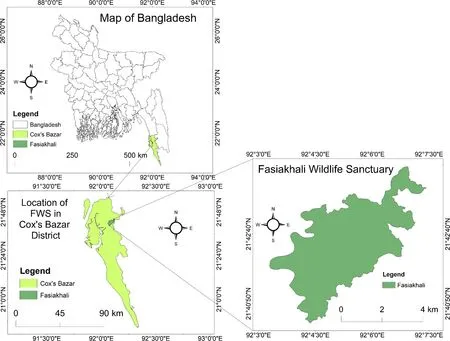
Fig.1 Fasiakhali Wildlife Sanctuary in Cox’s Bazar district of Bangladesh
An ecosystem is an assemblage of plants growing together in a particularlocation characterized either by its component species or by the combination of structural and functional features that characterize the appearance or physiognomy of the vegetation(Moore and Chapman 1986).The minimum quadrat size was determined to be 20 m×20 m through a species area curve for phytosociological sampling.Eighty sample plots were surveyed to assess species composition to ensure a 0.25%sampling intensity.Plot boundaries were demarcated and each species identified by local and scientific names.Plant samples were collected in the case of unknown species for the herbarium and identification later using reference herbarium and taxonomic books(Prain 1903;Heinig 1925;Siddiqui et al.2007;Ahmed et al.2008;Pasha and Uddin 2013).To overcome the difficulties of identification,taxonomists from BFRI and the Department of Botany were consulted.The number of tree species were counted and each measured for DBH and total height.
Data analysis
The data were analyzed to calculate relative density(RD),relative frequency(RF),relative dominance(RDo),relative abundance(RA)and importance value index(IVI)for each species following methods by Moore and Chapman(1986),Shukla and Chandal(2000),Ambasht(1978)and Dallmeier et al.(1992).Shannon–Wiener diversity index and Simpson’s diversity index were calculated following Shannon and Wiener(1963)and Simpson(1949).Height and DBH were used to determine the structural composition.Tree individuals and diameters were used to calculate stem density and basal area of all the species(Anderson and Ingram 1989).
Results
Species composition
The results reveal a total of 32 tree species with DBH≥11 cm belonging to 24 genera and 19 families(Table 1).Dipterocarpaceae and Mimosaceae families were represented by five species each followed by the Myrtaceae and Combretaceae(three species each)and Moraceae(two species).The remaining 14 families were represented by only one species.Tree stem density(249 stems/ha)in the FWS was poor.Species richness and density consistently decreased with increasing stem size from 11 to>70 cm DBH.Almost all the species occurred naturally except forTectona grandis,Acacia auriculiformisandAcacia mangiumwhich were used as plantation species.
Phytosociological attributes of the tree species
Forest structure,composition and dynamics are some of the essential features that help in developing suitable silvicultural systems for managing forest sustainably(Appanah et al.1990).Comparative ecological status of the species of the FWS were quantified by relative density(RD%),frequency(RF%),abundance(RA%),dominance(RDo%)and importance value index(IVI).This study found 249 stems/ha for density and 46.17 m/h basal area for trees having DBH≥11 cm.
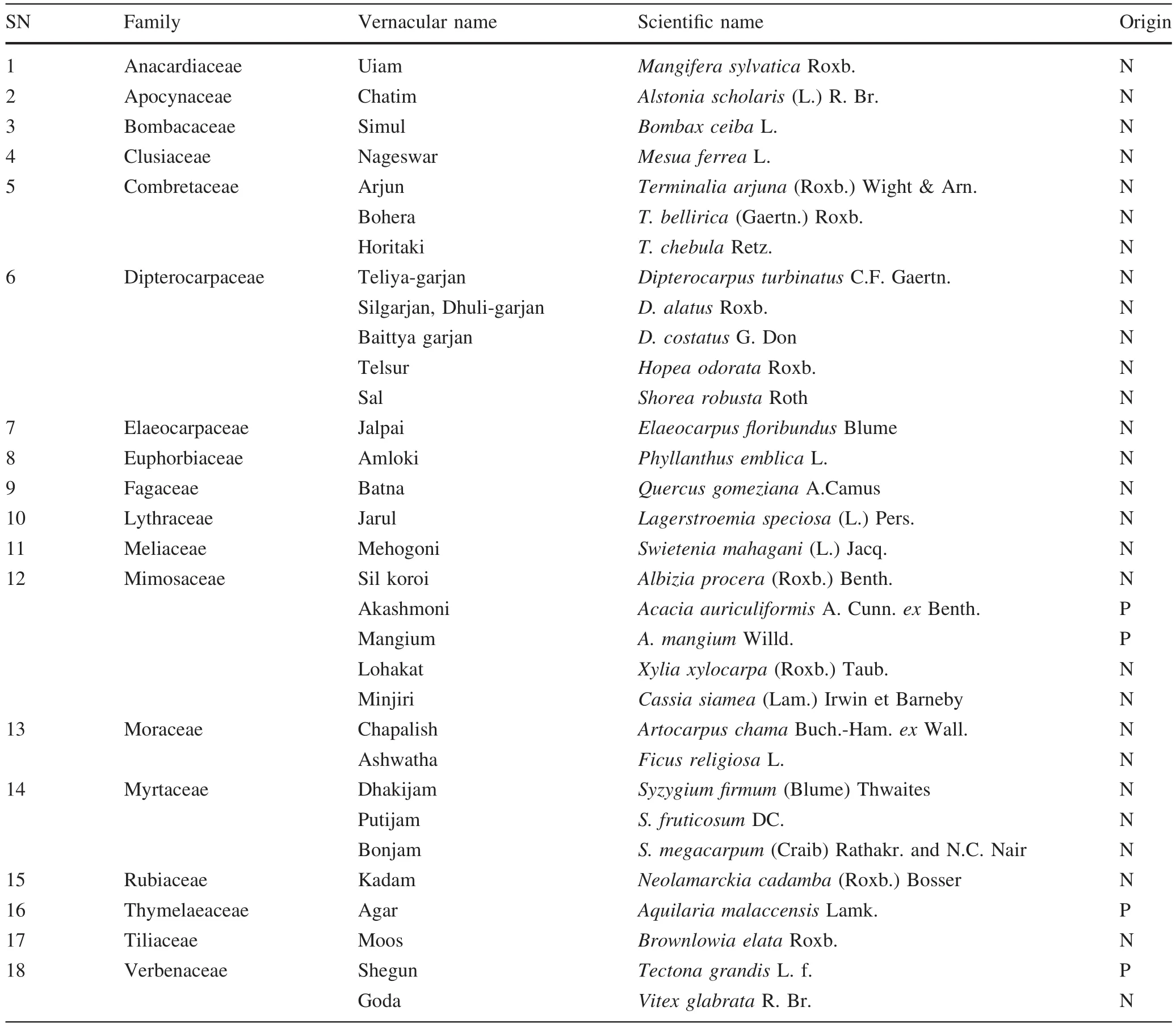
Table 1 Tree species from the Fasiakhali Wildlife Sanctuary
Among the naturally growing species,Dipterocarpus turbinatus(104 stem/ha)had maximum stem density followed bySyzygium firmum(56 stem/ha).D.turbinatushad a maximum basal area(23.1 m2/ha)followed byS. firmum(9.6 m2/ha).Of the native species,D.turbinatuswas the most dominant with a maximum RD(42.4%),RF(29.7%),RDo(53.2%)and IVI(125.3),followed byS. firmumwith 22.8%RD,18.5%RF,20.8%RDo and 62.1 IVI(Table 2 and Fig.2).On the other hand,among the plantations species,T.grandisshowed a maximum RD(9.2%),RF(7.2%),RDo(8.2%)and IVI(24.7).A.mangiumandLagerstroemia speciosawere the two co-dominant species afterT.grandis.
Family importance value index(FIVI)
The forest was commonly known as the Garjan tract and renowned for Garjan(Dipterocarpussp.)and Dhakijam(Syzygium firmum)(Fig.3).Though depletion of the Dipterocarp population in the last several decades,the dominance of Dipterocarpaceae verifies the presence of patches ofD.turbinatus,D.costatus,D.alatusspecies.The family importance value indicated thatDipterocarpaceae and Myrtaceae were the most species rich families.
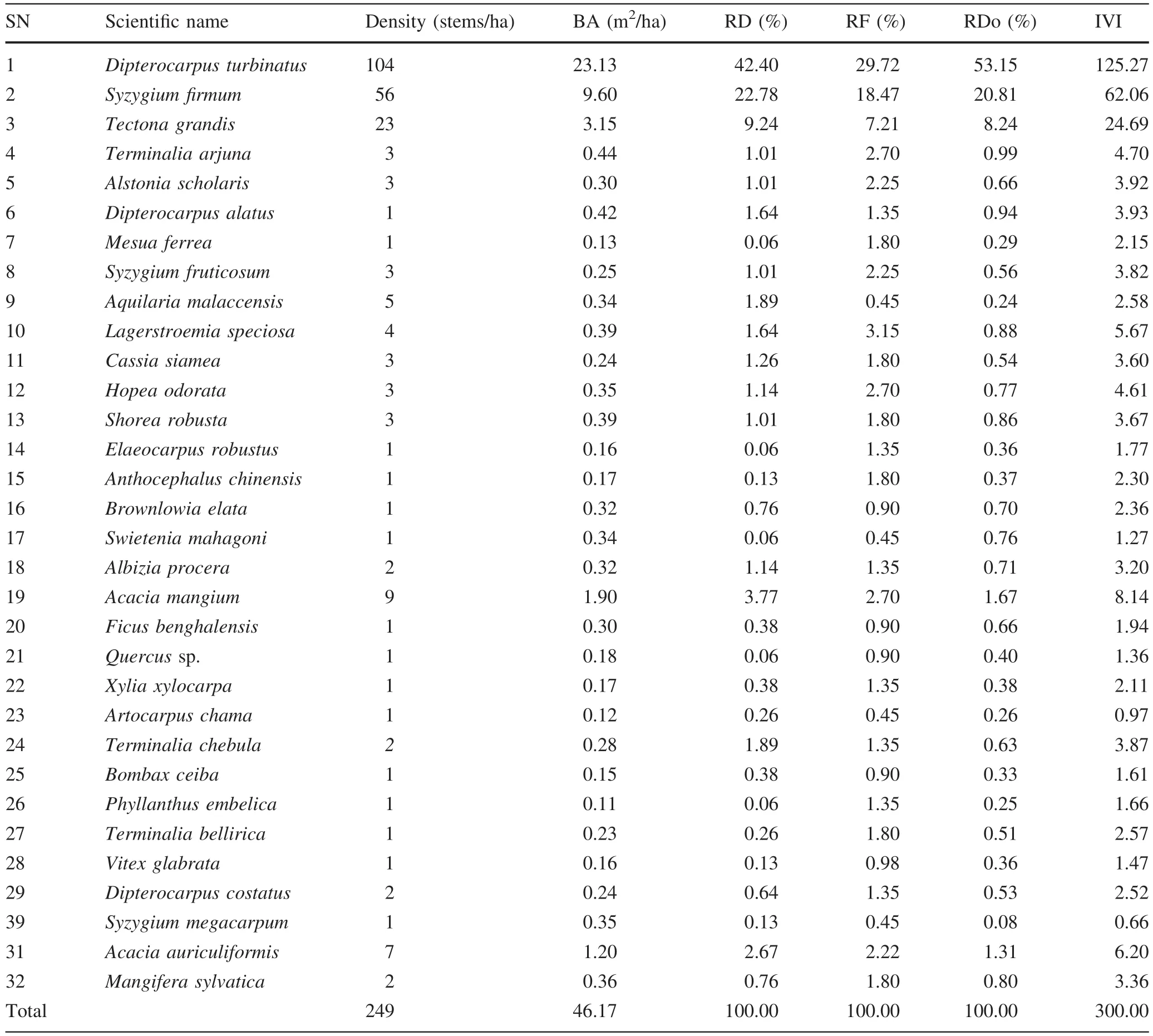
Table 2 Phytosociological attributes of tree species in FWS
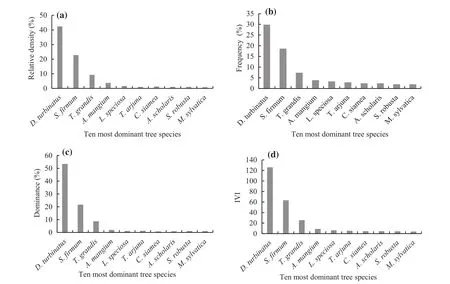
Fig.2 Comparative ecological status of the species.a Relative density(%),b frequency(%),c dominance(%)and d importance value index(IVI)of the ten most dominant tree species
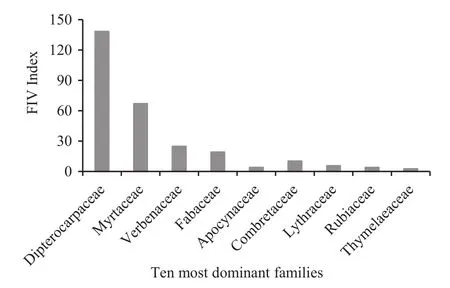
Fig.3 Family important value(FIV)index of the ten most dominant families
Hierarchical cluster analysis based on dominance of the recorded trees
Cluster analysis of the groups of species indicated that the recorded species could be grouped into four hierarchical clusters based on their dominance in the study area.The clusters vary with species numbers and composition.D.turbinatus,the most dominant species,is the only species in cluster one(Fig.4).At the present time,there are substantially large mother trees scattered across the wildlife sanctuary giving it dominance over others.The succeeding dominant plantsS. firmumandT.grandisformed the next two clusters.The remaining species,forming one cluster,are similar.Enrichment plantations,especially withS. firmumandT.grandis,resulted in their dominance and the formation of separate cluster.
Tree species diversity
Diversity indices combine richness and evenness in a single measure,although usually not explicitly.Although there are others,the most commonly used diversity indices in ecology are the Shannon diversity and the Simpson diversity.In the study area,Shannon–Wiener diversity index and Simpson’s dominance index were 2.05 and 0.75 respectively.Measurement of biodiversity typically concentrates on the species level and diversity is one of the most important indices used for the evaluation of ecosystems at different scales(Ardakani 2004).A rich ecosystem with high species diversity has a high value of Shannon–Wiener diversity index,while a lower value indicates an ecosystem with little diversity.In the present study,the Shannon–Wiener diversity index(2.06)for tree species is comparatively lower than that the 2.98 reported by Nath et al.(2000)in the Sitapahar natural forest of Chittagong.The Simpson diversity index(0.76)in this study shows less species diversity and the dominance of a few species in the FWS.
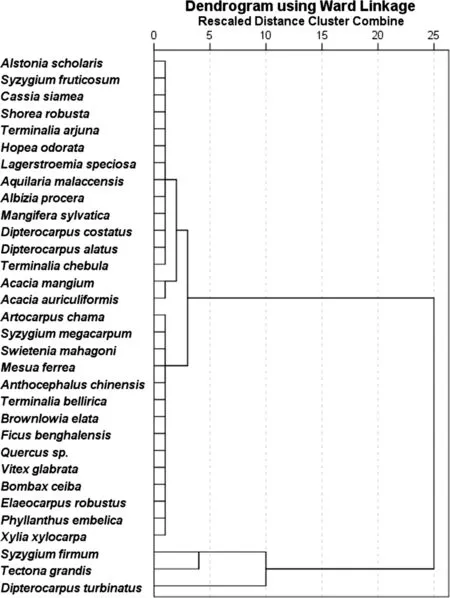
Fig.4 Cluster analysis of the tree species
Structural composition of FWS forests
Tropical forests are structurally stable,maintaining a decrease in number of trees with increasing diameter but this was not found in the Fasiakhali Wildlife Sanctuary.Species 41 to<51 cm DBH were dominant,followed by 51 to<61 cm and 31 to<41 cm diameter classes(Fig.5,Appendix S1).The DBH classes were dominated by a few species.D.turbinatusdominated the 41 to<51 cm class(15.3%of all individuals),the 51 to<61 cm class(13.8%)and the 61 to<71 cm(7.2%)class.S. firmumwas dominant in the 31 to<41 cm DBH range and co-dominant in the 41 to<51 cm(12.0%)and 51 to<61 cm(5.7%)DBH ranges.
This study found higher number of individuals(66.3%)in the 16–20 m height class,followed by the 11–15 and 21–25 m height classes(Fig.5,Appendix S2).This trend is similar to that of DBH class distribution.D.turbinatusandS. firmumare naturally straight and grow to significant heights.The higher height classes were dominated byD.turbinatusandS. firmum.
Discussion
A floristic inventory is a prerequisite for fundamental research in community ecology,and for modeling patterns of species diversity and understanding species distribution patterns.Under increasing anthropogenic pressures,tropical forests are disappearing at alarming rates by 1–4%of their current land area(Laurance et al.1998).
This study reports low tree species composition(32 species having DBH≥11 cm)compared with other forests in the Chittagong Forest Division.In similar studies Hossain et al.(2015)found 107 tree species belonging to 72 genera and 37 families from the Kamalachari Natural Forest of Chittagong South Forest Division.Motaleb and Hossain(2011)found 62 tree species from the Tankawati Natural Forest;Hossain et al.(2012)77 species from the Dudhpukuria natural forest,and Hossain and Hossain(2014)240 species in the Chunati wildlife sanctuary.The less heterogeneity of the forest ecosystem in terms of terrain may be the main reason for less species richness.
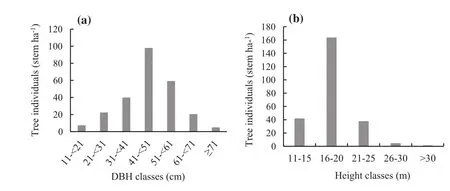
Fig.5 Distribution of species based on a DBH class and b height class
The IVI indicating overall dominance of the species indicated that three species(D.turbinatus,S. firmumandT.grandis),amongst the 32,were highly dominant with 70%of the total IVI.D.turbinatusalong with other Dipterocarps was dominant in CWS as reported by Hossain and Hossain(2014).Plantations raised by BFD resulted in the dominance ofT.grandisandS. firmumin the FWS.Other than these three species,A.mangiumandA.auriculiformiswere prominent in the FWS.These four-species account for 80.9%of the tree density and 84.4%of the basal area,and therefore constitute the framework of the forest.The high IVI exhibited byD.turbinatusis due to its higher relative frequency,density,and dominance compared to other species.The co-dominance ofS. firmumin terms of IVI is mainly due to its higher basal area and relative dominance compared to other species.The presence of many species with lower IVI values in this study is an indication that the majority are rare in the forest.
Cluster analysis by ecologists across the world i.e.,Sajib et al.(2016),Erenso et al.(2014),Flinn et al.(2008)and Sherman et al.(2008),identified similarities amongst plant groups and communities.In natural forests,most of the researchers identified five or six groups based on abundance and dominance.
The species diversity of FWS is poor in comparison to nearby forests and protected areas.The Shannon–Wiener diversity index(2.06)and Simpson’s Dominance index(0.76)is lower than that of the Sitapahar Reserve Forests(2.98),CWS(3.27–3.58),DDWS(4.45)and TNF(3.25)of Bangladesh according to the reports of Nath et al.(2000),Hossain and Hossain(2014),Hossain et al.(2013),and Motaleb and Hossain(2011)respectively.The south Chittagong and Cox’s Bazar region,including FWS was once very rich with Dipterocarp species(Hossain and Hossain 2014;Das 1980;Champion et al.1965).The population of Garjan(Dipterocarpspp.)in the larger growth classes is still higher now.Later,the forest was degraded by anthropogenic disturbances causing lowering recruitment of regeneration.However,results also indicate that there is higher number of garjan and dhakijam mother trees which produce profuse seeds and result in natural regeneration.If protection can be strengthened,natural regeneration would turn the PA into a denser one.
Illegal felling of trees and the introduction of exotic species,poverty and the attitude of people towards exploitation of trees,have resulted in less tree species diversity,the abnormal distribution of tree species in different growing classes and thus less stratification.Thefindings support the fact that natural forests have been facing serious onslaught and that a large portion has already been lost,leaving the country with only a small percentage of forest cover and poor plant diversity(Hossain and Hossain 2014).
Conclusion
This study gives an idea on the composition,structure and diversity of tree species of the FWS.When once there was a high diversity of species,various human activities,environmental factors and management-related problems are resulting in the loss of species day by day.FWS is much sensitive to different biotic disturbances.If forests can be protected in their present state with effective measures,diverting forest-dependent people towards non-forest related livelihood alternatives,then there is a possibility for this forest to develop into a dense and biodiversity rich ecosystem in the future.From the results of this study,Fasiakhali Wildlife Sanctuary is dominated by a relatively few tree species,and an enrichment plantation program with indigenous species should be carried to enhance species richness.
Project fundingAuthors’self-funded research.
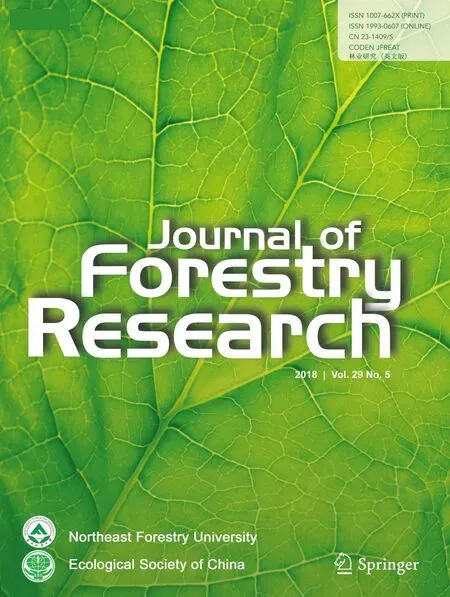 Journal of Forestry Research2018年5期
Journal of Forestry Research2018年5期
- Journal of Forestry Research的其它文章
- Environmental load of solid wood floor production from larch grown at different planting densities based on a life cycle assessment
- An overview of proven Climate Change Vulnerability Assessment tools for forests and forest-dependent communities across the globe:a literature analysis
- Assessing the vulnerability of a forest ecosystem to climate change and variability in the western Mediterranean sub-region of Turkey:future evaluation
- Effects of management regimes on carbon sequestration under the Natural Forest Protection Program in northeast China
- Mixed-effects modeling for tree height prediction models of Oriental beech in the Hyrcanian forests
- Estimation of a basal area growth model for individual trees in uneven-aged Caspian mixed species forests
